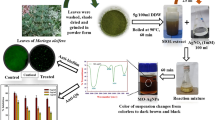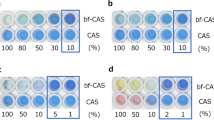Abstract
Pseudomonas aeruginosa SB1 was isolated from conventional well water. It produced an extracellular fluorescent bright green pigment which diffused into the growth medium. The purified pigment showed absorption maxima of 690, 370, 312 nm and was identified as pyocyanine, a known inhibitor of eubacterial and eukaryotic growth. The effect of this pigment when tested on orange-red pigmented halophilic archaeal isolates showed remarkable inhibitory activity and resulted in total growth inhibition at 4.67 mg/ml pyocyanine in 24 h. The present work is the first report on eubacterial Pseudomonas aeruginosa SB1 showing anti-Haloarchaeal activity.





Similar content being viewed by others
References
Altschul SF, Gish W, Miller M, Myers EW, Lipman DJ (1990) Basic local alignment search tool. J Mol Biol 215:403–410
Bailey DG, Birbir M (1993) A study of the extremely halophilic microorganisms found on commercially brine-cured cattle hides. J Am Leather Chem Assoc 88:285–293
Baron SS, Rowe JJ (1981) Antibiotic action of pyocyanin. Antimicrob Agents Chemother 20:814–820
Birbir M, Ilgaz A (1996) Isolation and identification of bacteria adversely affecting hide and leather quality. J Soc Leather Technol Chem 80:147–153
Braganca JM, Furtado I (2009) Isolation and characterization of Haloarchaea from low-salinity coastal sediments and waters of Goa. Curr sci 96:1182–1184
Chmura NW, Pelczar MJ (1958) Enhancement of Pseudomonad pigment production by Serratia marcescens. J Bacteriol 77:518–519
Dakhama A, Lavoie MC, Noiie J (1989) Stimulatory and inhibitory effect of Pseudomonas on the growth of algae. Can Tech Rep Fish Aquat Sci 0(1714):46–51
Dakhama A, Noue dela J, Lavoie MC (1992) Isolation and identification of antialgal substance produced by Pseudomonas aeruginosa. J Appl Phycol 5:291–306
Daly JA, Boshard R, Matsen JM (1984) Differential primary plating medium for enhancement of pigment production by Pseudomonas aeruginosa. J Clin microbiol 19:742–743
Davison J (1986) Plant beneficial bacteria. Biotechnol 6:282–286
Defago G, Hass D (1990) Pseudomonas as antagonist of soil borne plant pathogens: Mode of action and Genetic analysis. Soil Biochem 6:249–291
Dwivedi D, Johri BN (2003) Antifungals from fluorescent Pseudomonas: Biosynthesis and regulations. Curr Sci 85:1693–1703
Ficker M, Krastel K, Orlicky S, Edwards E (1999) Molecular characterization of a toluene-degrading methanogenic consortium. Appl Environ Microbiol 65:5576–5585
Gobbetti M, Corsetti A, Smacchi E, Rossi J (1997) Purification and characterization of a protenaceous compound from Pseudomonas fluorescens ATCC 948 with inhibitory activity against some Gram-positive and Gram-negative bacteria of dairy interest. Lait 77:267–278
Graikoski JT (1973) Microbiology of cured and fermented fish. In: Chichester CO, Graham HD (eds) Development in food microbiological safety of fishery products. Academic Press, New York
Grant WD, Larsen H (1989) Extremely halophilic archebacteria. In: Staley JT, Bryant MP, Pfennig N, Holt JG (eds) Bergey’s manual of systematic bacteriology, vol 3. Williams & Wilkins, Baltimore, pp 2216–2233
Hassan HM, Fridovich I (1980) Mechanism of the antibiotic action of pyocyanine. J Bacteriol 141:156–163
Javor BJ (1989) Hypersaline environments: microbiology and biogeochemistry. Springer-verlag, Berlin
Kushner DJ, Kamekura M (1988) Physiology of halophilic eubacteria. In: Rodriguez-Valera F (ed) Halophilic bacteria, vol 1. CRC press inc, Boca raton, FL, pp 109–140
Laursen JB, Nielsen J (2004) Phenazine natural products: Biosynthesis, Synthatic analogues and biological activity. Chem Rev 104:1663–1685
Mavrodi DV, Blankenfeldt W, Thomashow LS (2006) Phenazine compounds in fluorescent Pseudomonas spp. Biosynthesis and regulation. Annu Rev Phytapathol 44:417–445
Mazzola M, Cook RJ, Thomashow LS, Weller DM, Piersom LS III (1992) Contribution of Phenazine antibiotic biosynthesis to the ecological competence of Fluorescent pseudomonas in soil habitats. Appl Environ Microbiol 8:2616–2624
Oblinger JL, Kraft AA (2006) Inhibitory effect of Pseudomonas on selected Salmonella and bacteria isolated from poultry. J Food Sci 35:30–32
Saha S, Thavasi R, Jayalakshmi S (2008) Phenazine pigments from Pseudomonas aeruginosa and their application as antibacterial agent and food colourants. Res J Microbiol 3:122–128
Shahmohammadi HR, Asgarini E, Terat H, Saito T, Ohyama Y, Gekko K, Yamamoto O, Ide H (1998) Protective role of bacterioruberin and intracellular KCl in the resistance of Halobacterium salinarium against DNA-Damaging agent. J Radiat Res 39:251–262
Sorensen RU, Klinger JD, Cash HA, Chase PA, Dearborn DG (1983) In vitro inhibition of Lymphocytes by Pseudomonas aeruginosa phenazine pigments. Infect Immun 41:321–330
Thompson JD, Gibson TJ, Plewniak F, Jeanmougin F, Higgins DG (1997) The CLUSTAL_X windows interface: flexible strategies for multiple sequence alignment aided by quality analysis tools. Nucleic Acids Res 25:4876–4882
Turner JM, Messenger AJ (1986) Occurrence, Biochemical and physiology of phenazine pigment production. Adv Microb Physiol 27:211–275
Ulmer AJ, Pryjma J, Tarmek Z, Ernst M, Flad HD (1990) Inhibitory and stimulatory effect of Pseudomonas aeruginosa on human T and B lymphocytes and human monocytes. Infect Immun 58:808–815
Acknowledgments
This work was supported by University Grants Commission, India (UGC) Major Research Project No: 34-500/2008.
Author information
Authors and Affiliations
Corresponding author
Rights and permissions
About this article
Cite this article
Salgaonkar, B.B., Kabilan, M. & Braganca, J.M. Sensitivity of Haloarchaea to eubacterial pigments produced by Pseudomonas aeruginosa SB1. World J Microbiol Biotechnol 27, 799–804 (2011). https://doi.org/10.1007/s11274-010-0519-z
Received:
Accepted:
Published:
Issue Date:
DOI: https://doi.org/10.1007/s11274-010-0519-z




